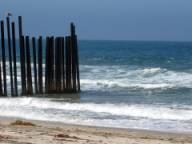Border Fence creates opportunities for some, but draws criticisms from others, with waivers of environmental reviews
by Gayle Early
 |
| Gayle Early. |
October 1, 2008 (El Cajon) - Congressman Duncan Hunter’s office hosted an informal briefing by the Army Corps of Engineers on September 18 on the status of the border fence construction and possible subcontracting opportunities for local businesses. Mary Spencer, the Army representative in the Small Business Association, also offered pointers on how to apply for contracts.
Mike Miller, the Army Corp’s Senior Project Manager for Southern California Projects, said that the majority of the fence work is already contracted out for each sector, but encouraged small businesses to contact companies who have received the MATOCs (Multiple Award Task Order Contracts) for subcontracting work. (Click MATOC link to see list.)
“After the fence is built, we still need work on the roads—they need to be improved to ‘make them real’—there’s work needed with lighting, fence maintenance and repair, projects to fill in—there’s lots in the hopper,” said Miller. Road improvement is critical, he added. “The fence is no good unless you can patrol it. The Border Patrol needs to have good access to that fence.”
 |
| Department of Homeland Security. |
Miller gave Hunter’s office a list of awarded contractors per sector from San Diego to Tucson, Arizona, that interested small businesses can contact. He mentioned that Homeland Security has spent $2 billion just this year in construction.
Miller said they were still on target to finish fence construction by December 31, 2008 but have to “accelerate” to make the deadline. One section, called BV-1, a vehicle fence nicknamed “The Normandy Project” needs imminent work, he said, prompting the call for local subcontractors.
According to the Government Accountability Office, the average cost for pedestrian fencing has risen this year from $4 million to $7.5 million per mile. Vehicle fencing, a system of spaced bollards, has risen from $2 to $2.8 million per mile. One 3.5-mile section in the southwestern-most corner will cost almost $60 million to complete.
The Border Patrol hired the Army Corps of Engineers to manage fence construction. “We have project delivery teams for each sector,” said Miller. They will be involved in out-years, he added, but longer term maintenance will eventually be outside the scope of the Army Corps and more the province of Border Patrol and Homeland Security.
Hunter, Chair of the Senate Armed Forces Committee from 2005 to 2007 and now its ranking member, has been the driving force behind building the 670-mile, multibillion dollar fence, portions running the 2,000 mile southwestern border from the Pacific Ocean to Texas.
Congressman Filner, Environmental Groups Fear Severe Consequences, Criticize Lack of Environmental Review
Congress initially appropriated $1.2 billion for the fence, under the Secure Border Initiative. Representative Bob Filner, whose district traverses the U.S.-Mexico border, expects completion costs to swell to $9 billion. Filner says the fence will do nothing to make our nation safer.
When the Secure Fence Act passed in 2006, erecting the fence became a matter of law. Homeland Security itself has not projected the final cost for building or maintenance. It awarded Boeing $933 million to develop the virtual portion of the fence, which had to be scrapped because, said Miller after the meeting, “it failed miserably.”
 |
| Gayle Early . |
Environmental groups have fought hard and lost every battle to save fragile ecosystems such as wetlands that harbor hundreds of bird species, desert migratory paths for jaguars, tortoises, and myriad plant species the fence will harm or destroy, many of which are already endangered or threatened. Groups such as the Sierra Club, Defenders of Wildlife, Audubon Society, the California Coastal Commission, all agree that the fence project represents a colossal environmental disaster.
Congress gave Homeland Security Secretary Michael Chertoff unprecedented power to waive any law that stands in the way of the fence, and so far he has waived 36 laws.
Filner, in an interview with border reporter Amy Isackson of KPBS, said, “To go ahead and do something that waives all the laws that protect our water, our air, our natural resources is really a crime to me and it sets a terrible precedent. And to waive environmental laws to do something that is not effective is not only criminal, it’s stupid.”
 |
| Department of Homeland Security. |
Miller, whose career with the Army Corps began as a biologist doing environmental restoration work, told ECM after the meeting that, “not understanding what’s happening out there, the fence seems crazy, but it’s an issue of value, of trade-off.” He said the Border Patrol hasn’t published numbers of apprehensions, fatalities, “but when you start looking into it you see the border is a scary place.” He added, “When you come back and tell the story with it being a war-zone in places at night, all of the sudden the fence makes sense.”
Gayle Early is a freelance writer who lives in La Mesa, California. She was a former senior technical and grant-writer with UCSD and editor for Academic Press/Harcourt Brace. You can find her blog at www.redroom.com/member/gayleearly.











Recent comments